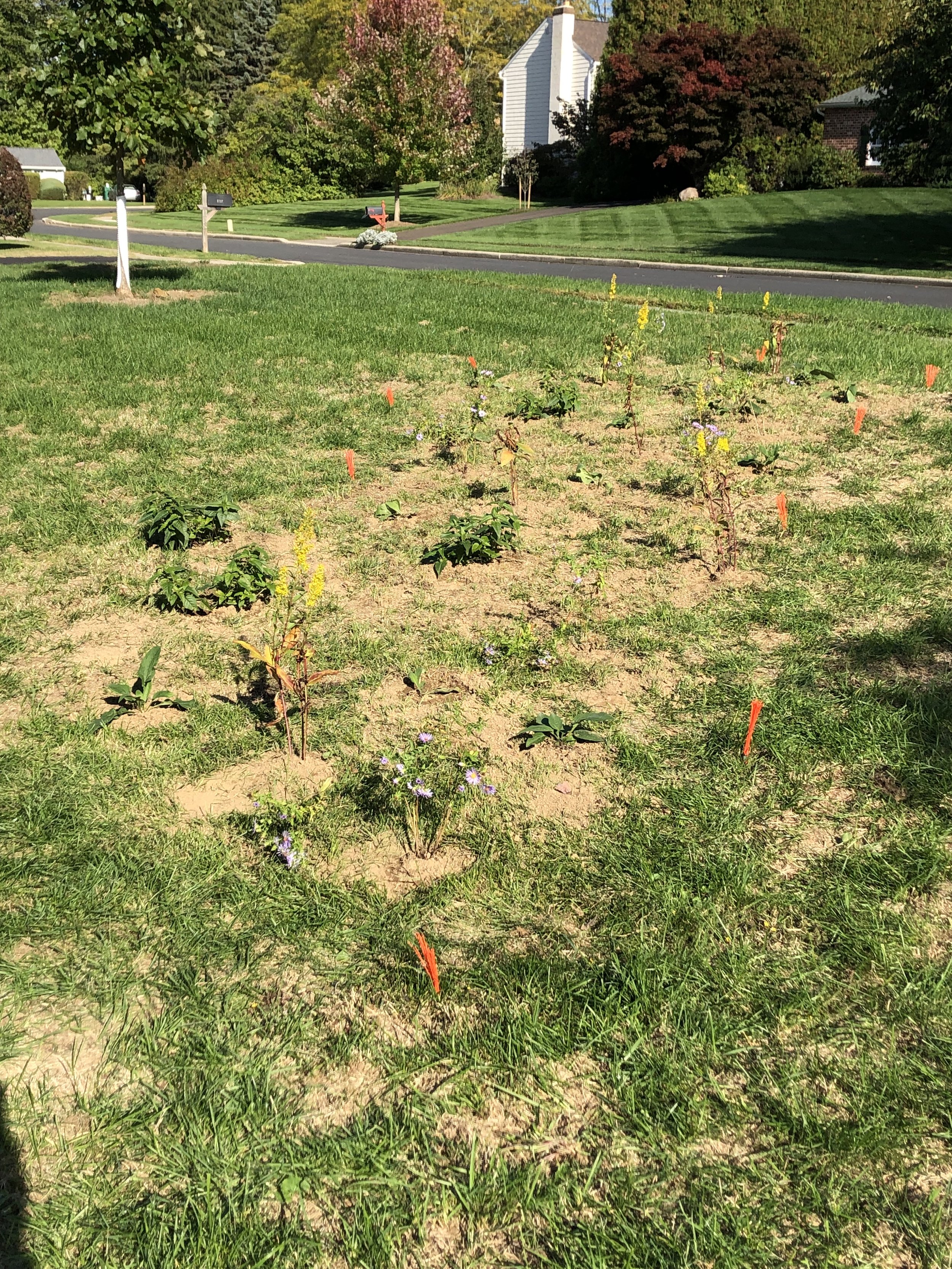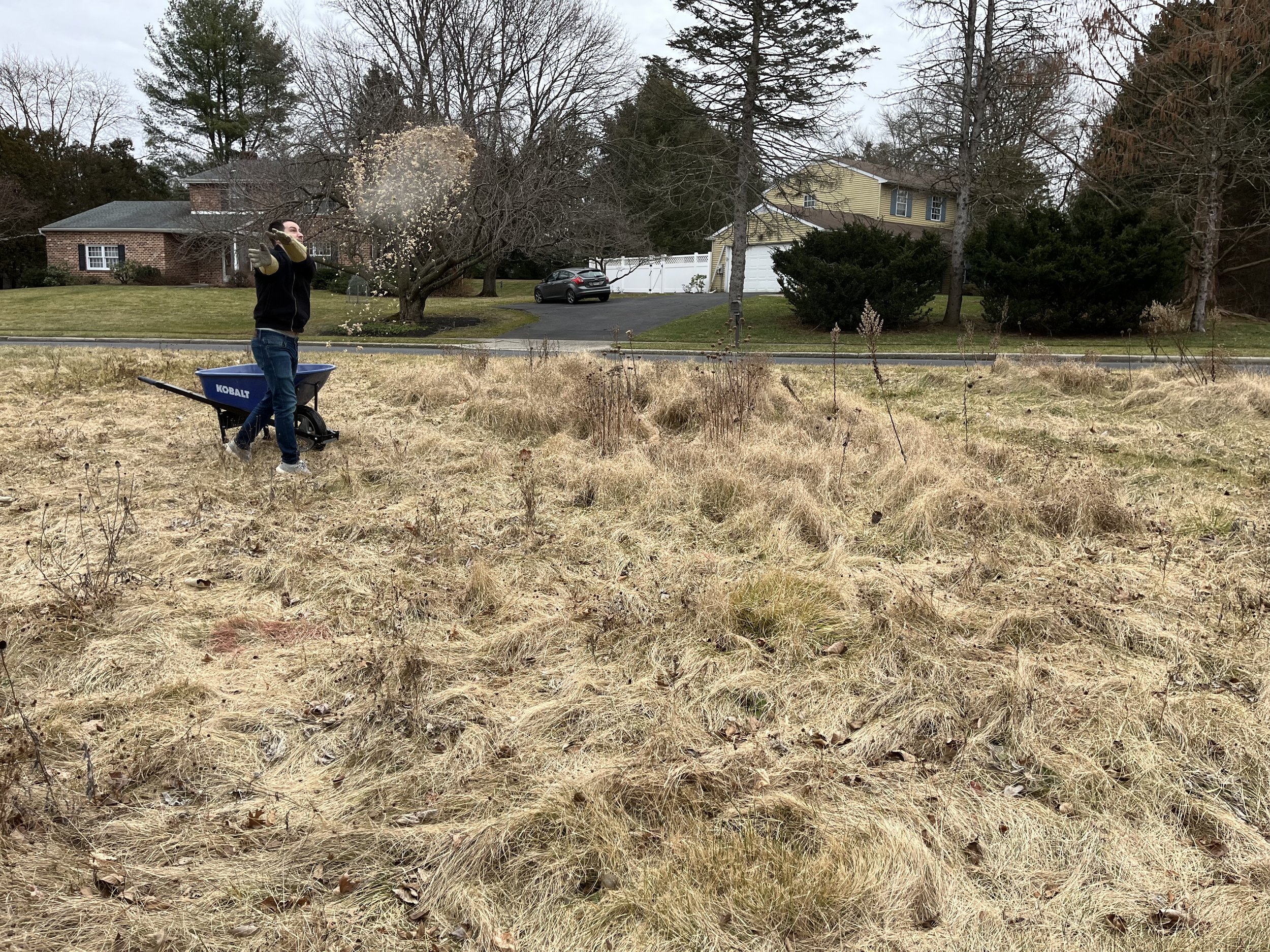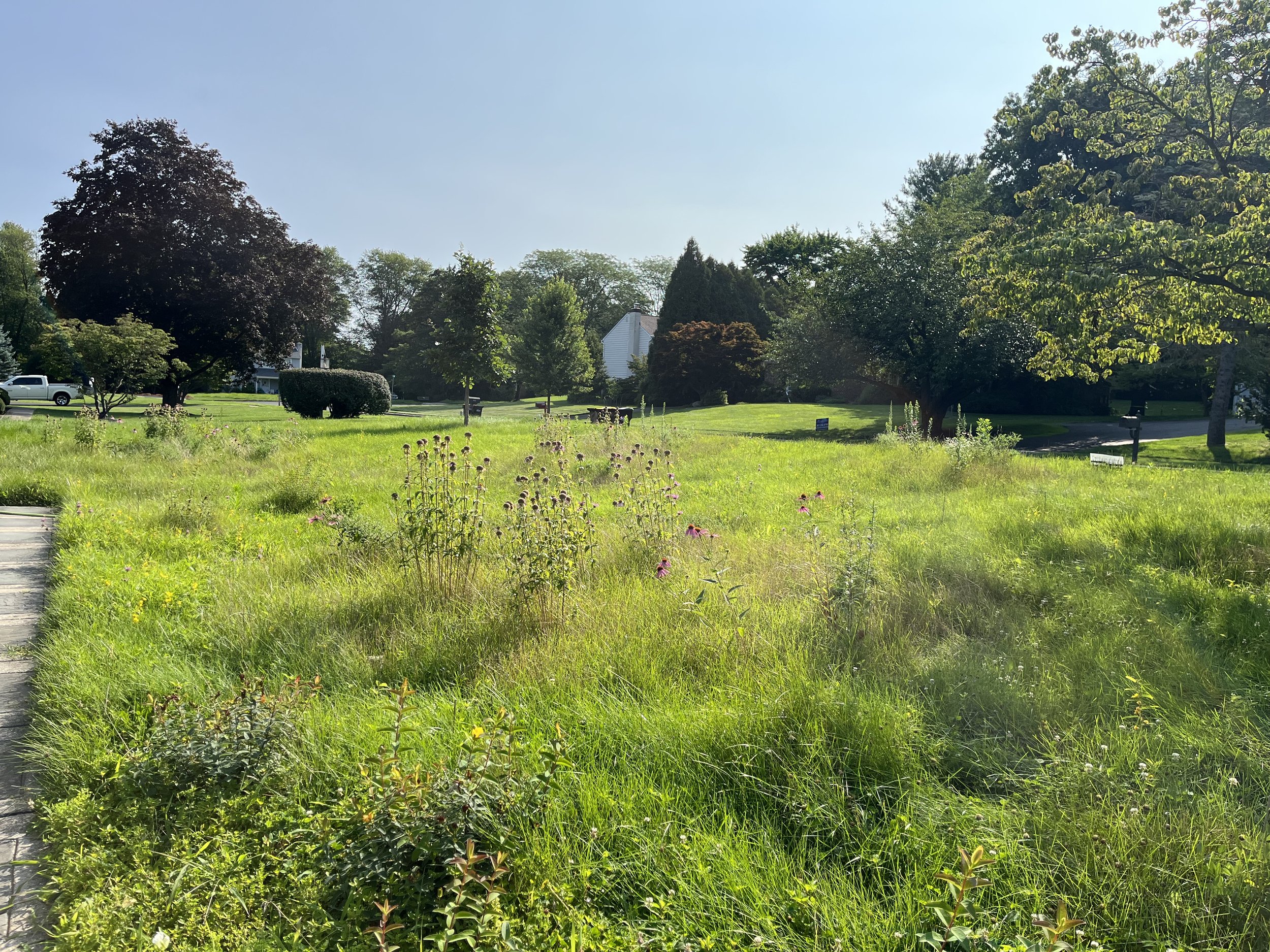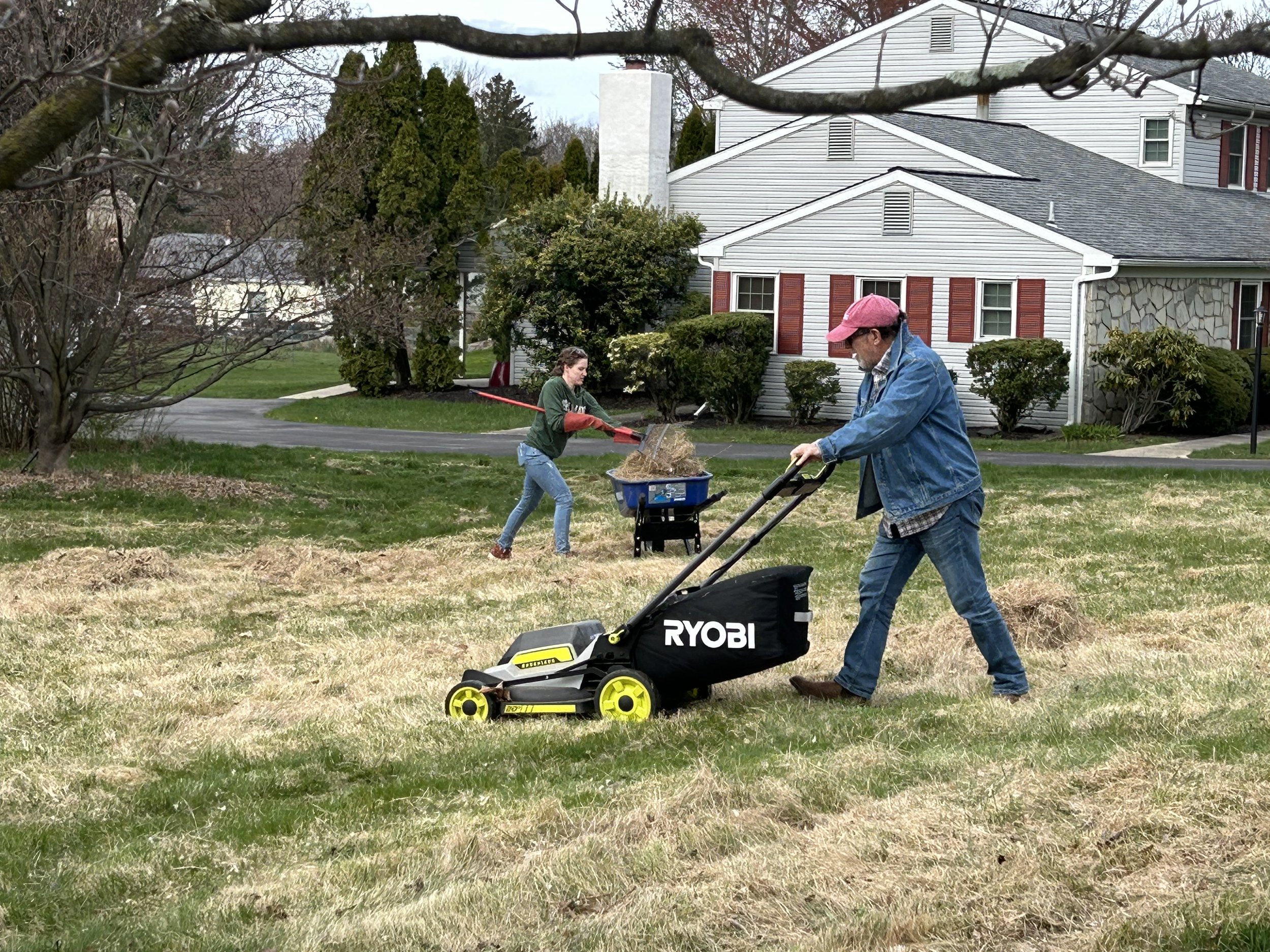An Experiment in Organic Lawn to Meadow Conversion: A Timeline
Photo by Larry Weaner two years after Sara & Evan Cooper began the transition from lawn to meadow.
In April of 2022, Sara and Evan Cooper moved into their new home in a suburban Philadelphia neighborhood. After one spring and summer of consistently mowing their ~5,000 square foot front lawn, Sara eagerly initiated the process of transitioning the lawn into a native wildflower meadow. However, she wanted to avoid three things: herbicide, heavy physical labor, and an extended “ugly” phase. Leaving the turf in place and guided by her father and Landscape Designer Larry Weaner, she began a turf-to-meadow conversion process that relied on light-touch actions that simultaneously weakened the lawn and strengthened her newly planted meadow. After two growing seasons, the results have exceeded expectations...enough to be featured in The New York Times in 2024.
Below, Sara shares an overview of their timeline from 2022 to early 2025.
Dive in deeper by joining Sara and Larry’s live virtual presentation on this transition
from both homeowner and expert perspectives - Sept. 3, 2025:
Registration open & recording viewable for 3 months.
Lawn to Meadow Transition Timeline
Please note: This timeline is site- and ecoregion-specific; all practices should be tailored to local conditions.
Sara and Evan live in the Northern Piedmont Ecoregion.
SEPT. 2022
● Power raked/dethatched the existing lawn (rented power rake)
Sept. 25, 2022
OCT. 2022
● Planted live perennial plants
● Applied sulfur* (mixed with hamster bedding to spread through the whole front yard)
○ Watered immediately after sulfur application
○ *In retrospect, a practice we would have done differently:
The amount of sulfur we used (12 lbs sulfur for our 5,000 sq. ft. front yard) was not enough to actually lower the pH. A good rule of thumb:
Aim for pH in the mid-5s.
If the soil pH is 7 or above, apply 50 lbs of sulfur per 5,000 sq. ft.
If the soil pH is 6 or above, apply 25 lbs of sulfur per 5,000 sq. ft.
This is not a scientific number, it really depends on soil type, hydrology, etc., but this is a good general rule of thumb. Also, this is only a pre-planting & early-stage action until the meadow has become established.
JAN. 2023
● Power raked/dethatched the existing lawn (rented power rake)
● Seeded*
○ *In retrospect, a practice we would have done differently:
While we seeded early-emerging, annual and biennial meadow species, Larry commented in April 2025 that in hindsight we should have seeded a mix that also included late-stage perennials. Early on it was not clear whether any of the seed would germinate through the turf, but upon learning how successful the seeded plants turned out to be, it would have been helpful to have those perennials coming in sooner.
APRIL-JUNE 2023
● Mowed turf grass as short as possible between the drifts (a handful of times) until seeded plants get as tall or taller than the turf grass
● Let turf grass grow tall around the live planted drift plants for deer protection (deer don’t like turf grass)
MAY 2023
● Observation: Partridge pea seedlings begin to appear through the grass outside the drifts
EARLY JUNE-EARLY SEPT. 2023
● Began watering with rainbirds as needed (1.5 - 2 hours 1-2x per week)
○ Watered 3 hours the first time because the live plants really needed it (drought)
○ Watered based on the moisture of the soil (if top few inches of soil is dry) and the look of the plants (curling, wilty), not just blindly 1-2x per week
● Mowed paths through meadow
JUNE 2023
● Applied sulfur (mixed with hamster bedding)
○ Watered immediately after sulfur application
● Weed whipped tall turf grass in live planted drifts
○ Sprayed newly-exposed live plants with organic deer repellant, continued after rainfall as needed through summer
NOV. 2023
● Applied sulfur (mixed with hamster bedding)
○ Watered immediately after sulfur application
FEB. 2024
● Applied sulfur (mixed with hamster bedding)
○ Watered immediately after sulfur application
MARCH 2024
● Rented walk-behind/self-propelled brush hog mower and mowed whole front yard except planted St. John’s Wort
○ Raked and moved cut brush to backyard compost pile (don’t want it covering the ground that we want exposed to sun)
● Mowed with regular electric mower on a pretty low setting (not too low to cut emerging seeded & live plants
● Weed whipped specific areas of weeds/grass to the bare soil (scalped) for maximum sun exposure for seeded plants to grow
APRIL-MAY 2024
May 28th, 2024
● Mowed turf grass as short as possible between the drifts (a handful of times) until seeded plants get as tall or taller than the turf grass
LATE JUNE-EARLY JULY 2024
● Watered twice for ~3 hours each time
● Sprayed live planted plants with organic deer repellant after rainfall through summer
JUNE-AUGUST 2024
● Managed for aesthetics (weed whip plants drooping into paths, mow paths, edges)
June 28th, 2024
DEC. 2024
● Planted additional live plants throughout drifts to help fill in the drift areas more
● Landscape management crew weed whipped whole meadow, leaving stems 3-4 inches tall for wintering insects
MARCH 2025
● Observation: First signs of green growth - live planted drift plants
● Raked whole meadow area to disturb remaining brown turf laying flat
○ Removed thatch & leaves and put in backyard compost pile
PLANNED:
APRIL 2025
● Seed additional seed mix (longer-term perennials)
MAY 2025
● Plant additional live plants










